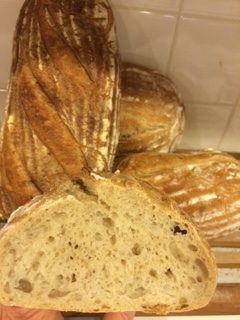October 6, 2016 - 11:17am

Need help scoring. First loaves w new oven.
 My first loaves from new oven. With combination of T65 and 10% rye. Levain was made then left overnight, then dough next day to bulk rise and finally shaped and put in fridge overnight. Baked right out of oven. Taste is lovely. Subtle, sweet and sour.
My first loaves from new oven. With combination of T65 and 10% rye. Levain was made then left overnight, then dough next day to bulk rise and finally shaped and put in fridge overnight. Baked right out of oven. Taste is lovely. Subtle, sweet and sour.
Need advice about scoring. My ears are neither deep enough nor wide enough. All suggestions appreciated.
Thanks in advance
hester


If you haven't read Scoring Bread: An updated tutorial I suggest you do so. It might help.
One suggestion that is not mentioned in the tutorial: If you are working on getting better bloom/grigne and/or ears from your scoring, start with a single longitudinal slash, like this:
That will be easier to de-bug. Once you have a single slash mastered, you can apply those same skills to multiple slashes. Okay?
After you have read the tutorial, if you have more questions, please ask. And Shonah tovah!
David
Going to look now. Oh and I Have more bread rising (final rise) to bake in one hour so your tutorial is very timely, thanks again.
And back at you for a sweet year.
hester
Inquiring minds want to know.
I use a "Super Peel." In fact, I have two. One is their regular size, and the other is larger. Google "super peel" and you will find them through OXO, Amazon dot com, Breadtopia dot com and elsewhere.
I have used this for years now, since they first came out. I love it.
(No affiliation other than very happy user of the products.)
David
the slits close up quickly. Does that mean my oven is too hot, or the scoring isn't deep enough? Or too deep?
Thanks
@David
I made 2 recipes, 9 loaves. lol. Last one after seeing your tutorial videos.
I think the scoring is looking better. It would easier to advise you if I knew the formula and procedures you are using.
That said, if your ear is forming then collapsing, your cut is too deep. That's covered in the tutorial section on ears.
Ragged cuts usually mean the scoring is done too slowly. You have to stop thinking and make an un-hesitating, fast cut. The movement should be almost entirely at your shoulder, not your elbow, wrist or fingers. Ragged cuts are harder to avoid with high-hydration doughs. The raggedness comes from dough sticking to the blade, so drier (less sticky) dough, a sharper blade, faster movement are the methods for achieving a smooth margin.
Hope this helps.
David
Ok, the learning curve is step. I read somewhere that this guy who worked in a bakery said it took him a full year of full time work to get the scoring right.
Next ones will be quicker and shallower. Thanks
hester